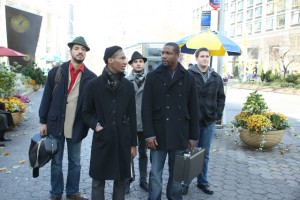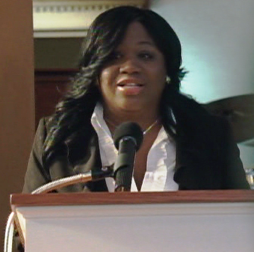Keepin’ it Real on Treme
 I’m a newcomer to New Orleans, but it’s my place, and I have a proprietary interest in what Treme means to my city. Its economic impact, analyzed by Vicki Mayer in an earlier column, is complicated: the tax breaks handed out to HBO may not be worth it if the money that the production spends here doesn’t get where it’s needed most and if the tourism that’s supposed to be generated by the show doesn’t make up for lost revenue.
I’m a newcomer to New Orleans, but it’s my place, and I have a proprietary interest in what Treme means to my city. Its economic impact, analyzed by Vicki Mayer in an earlier column, is complicated: the tax breaks handed out to HBO may not be worth it if the money that the production spends here doesn’t get where it’s needed most and if the tourism that’s supposed to be generated by the show doesn’t make up for lost revenue.
On the face of it, Producer/creators Eric Overmayer and David Simon can’t do enough for the city. Treme is a love letter to New Orleans, famously praised by local bloggers and national NOLA-loving critics alike for “getting it right.” At the same time, these critic/fans are markedly uncritical of the trickle-down argument that increased tourism from Treme will make up for lost taxes. One can’t help but wonder how they would respond to the same case if it were made by, say, a manufacturer. But it’s hard to focus on mundane questions when Treme says the one thing about New Orleans that was always my answer when my midwestern neighbors asked “Why do you want to move there? Why? Because it’s the coolest city in the United States.
Simon and Overmayer clearly agree, and most episodes of Treme could be subtitled “The Hipster’s Guide to New Orleans.” From the beginning, every episode has been crammed full of references to bars, nightclubs, and restaurants—these are the good places, where we go to eat, hang out, and listen to music. The Spotted Cat and d.b.a. on Frenchmen, The Bon Temps Roule on Magazine, and Vaughn’s and Bullet’s farther out—these are the kind of places people don’t hit on their first or even second trip to the city, and before their shout-outs on Treme, you could still get a seat there.
The hip traveler’s to do list of restaurants, clubs, and musicians not to miss on their next trip was notably absent in this episode. Instead, “Slip Away” opened with the funeral of Dinneral Shavers, high school band teacher and drummer for the Hot 8 Brass Band. In a show known for intertextuality, where characters are based on real people and real people play themselves, “Slip Away” went a step (or several) further, re-enacting the actual funeral of Dinneral Shavers that took place in 2006, right down to the eulogy given by his real sister Nikita. There wasn’t much fun in this funeral as we see close ups of her anguish and that of the New Orleans musicians who were friends of Shavers and attended the original event. No acting classes needed for these guys—the grief seemed fresh and raw.
With Dinneral’s funeral, Simon and Overmayer return to what is familiar territory for them and address the upsurge in violent crime that shook New Orleans in 2006. LaDonna’s rape in the previous episode is a fictional introduction to two real murders: Shavers’ and the shooting of Helen Hill, a filmmaker killed in her home in the Marigny. The script becomes more documentary than drama as the ensuing (scripted) city-wide march against violence is juxtaposed with actual news footage taken at the time. Film of actors and extras re-enacting the march is intercut with shots of a bewildered-looking then-Mayor Ray Nagin trying to respond to protesters and with live footage (ca. 2006) of Glenn David Andrews (who appears in the 2011 re-enactment of the funeral) speaking at the rally. The episode ends with LaDonna, safe (but not feeling that way) in Baton Rouge, watching the coverage as a lone customer as Gigi’s back in New Orleans does the same.
The producers/writers on Treme are under tremendous pressure: they ache to do right by New Orleans, they have to make a television show that people will continue watching, and they want to tell the truth about the city putting itself back together after the storm. For my part, I’m starting to agree with those who argue that the show’s worshipful focus on New Orleans culture has occupied too much screen time at the expense of other things that make people watch. But in an attempt to “get real,” the endless name-checking of musicians has been replaced in part by court cases about exorbitant police fees for Second Lines (with attorneys and judges playing themselves) and problems with the Sewerage and Water Board. Once the writers run out of items for the show’s “Cool New Orleans” travelogue, their quest for verisimilitude will have Treme painted into a corner. Real life is boring and tedious, except when it isn’t, and then it’s too painful for words. I can’t predict what viewers will say about re-enacting a real funeral even with the permission of the family, but I’m glad I don’t have to take the heat for it.
Treme just hired a new writer, the first woman on their team, and already there are hints that things will be happening in the lives of Albert, Janette and Delmond. Some of my friends and I are rooting for Toni to hook up with a sexy younger musician. (Anybody out there listening?) Overmayer and Simon have more than established their street credibility as far as this New Orleanian is concerned. They’ve been keepin’ it real. Now’s the time to start makin’ it up.




I love the idea of Keepin’ It Fictional. Definitely what the city needs a little of.
I think it’s unfair to bring up the tax inducements offered to the entire film industry as if some special arrangements were made for Simon and Company. They were not. If not to Treme, they would have gone to the latest penny dreadful Hollywood flick here to film.
Do I detect a hing of jealously that Treme let the Spotted Cat out of the bag? I can’t fault you, as it’s often too crowded lately to bother. Still, what the Treme team have tried to do is paint a picture of the critical issues New Orleans faced, and the failure of most institutions (at all levels) to address them.
And from the start the concern of so many people (not just us bloggers) was whether the city’s people would return, or whether there would be some attempt to rebuild a Potemkin New Orleans more suitable for tourists and economic development. As you admit, New Orleans without its unique culture would just be another southern city, one past its prime.
The active blogging community has mostly rallied behind Treme because of the tens of thousands of hours we have spent in the last five plus years trying to tell that story to the world, to make sure as best we could things happened right, because Treme does in fact mostly get it right.